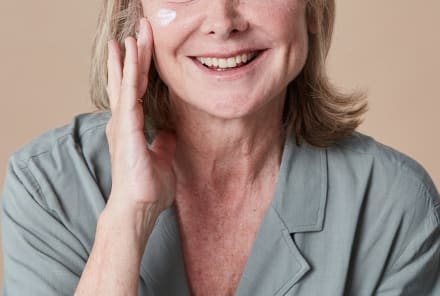Advertisement
Is 60 Seconds of Exercise Enough? What An Expert Says About HIIT for Better Cardio


What if someone told you that just 1 minute of exercise could significantly boost your cardiovascular health and improve your VO2 max? It might sound too good to be true, but Martin Gibala, Ph.D., is here to explain how high-intensity interval training (HIIT) makes it possible.
Gibala, a professor of kinesiology at McMaster University, joined us on the mindbodygreen podcast to discuss his research on exercise physiology and his recent book, The One-Minute Workout.
This style of exercise is incredible for its efficiency, but it's not just about time—it’s about results. Whether you're navigating a hectic schedule or on the lookout for a new fitness routine, HIIT may be the key to a longer, healthier life.
A quick VO2 max overview
VO2 max—a crucial measure of how efficiently your body uses oxygen during exercise—is one of the strongest predictors of heart health and longevity.
The higher your VO2 max, the better your body is at delivering oxygen to your muscles during physical activity, leading to improved endurance, stronger cardiovascular health, and overall better fitness. So, when it comes to VO2 max, HIIT can be a game changer.
So…what is HIIT?
HIIT, or high-intensity interval training, involves repeated bursts of hard work followed by recovery periods. But what exactly qualifies as “hard”? That can vary depending on your fitness level, how well-rested you are, and even your mood that day. Vigorous exercise is typically defined as working at around 77-80% of your maximum heart rate, which feels like a 7 or 8 out of 10 on a scale of effort. It’s the kind of intensity where you can’t hold a conversation but can still manage to spit out a few words.
The beauty of HIIT is that you can adjust the intensity to match where you're at on any given day. What’s “hard” today might feel easier tomorrow. But the key is pushing yourself into these higher-intensity zones because even a short burst of hard work can significantly enhance the efficiency and endurance of your cardiovascular system. Over time, this boosts your VO2 max, leading to long-term health benefits.
How to do the 1 minute workout
You don’t need hours in the gym to see results. In fact, Gibala’s research has shown that just three 20-second bursts of intense exercise can improve VO2 max—just as effectively as traditional, longer workouts. This is how you can maximize the benefits in just 10 minutes:
- Warm up for 2-3 minutes – move around to get your heart rate up.
- 20-second all-out sprint – whether on a bike, running, or rowing, push as hard as you can.
- Recover for 2 minutes – slow down and catch your breath.
- Repeat a 20-second sprint – go hard again!
- Recover for 2 more minutes – keep it light.
- Final 20-second sprint – give it everything you’ve got!
- Cool down – relax for another minute or two.
That’s it! By pushing yourself during those 20-second bursts, you’re improving the efficiency of your heart and lungs. The best part? You’re only spending 1 minute in those high-effort zones. Do this routine three times a week, and you’ll be on your way to better overall fitness.
How much HIIT is too much?
While HIIT can be incredibly efficient, it’s not something you should overdo. Too much can lead to diminishing returns or even injury. Gibala emphasizes moderation and variety. Three sessions a week of HIIT is plenty to see improvements in VO2 max and metabolic health, but it’s crucial to mix in moderate-intensity exercise, strength training, and rest. The key is variability—don’t only rely on HIIT. By balancing different types of exercise, you’ll avoid overtraining and injury.
Training for longevity
Whether your goal is to get fitter, run a race, or simply feel great as you age, training for longevity is about consistency and variety. A balanced routine is key. Incorporating two to three HIIT sessions per week alongside strength training and moderate activities like walking or swimming can optimize your fitness and well-being. With its ability to improve VO2 max and boost cardiorespiratory health, HIIT is a powerful tool for a longer and stronger healthspan.
Benefits of HIIT
Beyond the obvious cardiovascular benefits, HIIT also improves metabolic flexibility—your body’s ability to switch between burning carbs and fats for energy. This is crucial for managing blood sugar levels, improving insulin sensitivity, and reducing the risk of type 2 diabetes.
HIIT also benefits brain health, promoting neurogenesis (the creation of new brain cells) and improving cognitive function. With all the benefits for your heart, metabolism, and brain, HIIT truly delivers a full body-and-mind upgrade.
The takeaway
Gibala’s research proves that you don’t need to spend hours sweating it out to improve your health. By incorporating just a few short bursts of intense exercise into your weekly routine, you can significantly boost your VO2 max, strengthen your heart, and enhance your endurance. Plus, HIIT has the added perks of better metabolic flexibility, improved brain function, and increased longevity. It’s a quick and efficient way to invest in your health—one minute at a time.
Watch Next
Enjoy some of our favorite clips from classes
Enjoy some of our favorite clips from classes
What Is Meditation?
Mindfulness/Spirituality | Light Watkins
Box Breathing
Mindfulness/Spirituality | Gwen Dittmar
What Breathwork Can Address
Mindfulness/Spirituality | Gwen Dittmar
The 8 Limbs of Yoga - What is Asana?
Yoga | Caley Alyssa
Two Standing Postures to Open Up Tight Hips
Yoga | Caley Alyssa
How Plants Can Optimize Athletic Performance
Nutrition | Rich Roll
What to Eat Before a Workout
Nutrition | Rich Roll
How Ayurveda Helps Us Navigate Modern Life
Nutrition | Sahara Rose
Messages About Love & Relationships
Love & Relationships | Esther Perel
Love Languages
Love & Relationships | Esther Perel
What Is Meditation?
Box Breathing
What Breathwork Can Address
The 8 Limbs of Yoga - What is Asana?
Two Standing Postures to Open Up Tight Hips
How Plants Can Optimize Athletic Performance
What to Eat Before a Workout
How Ayurveda Helps Us Navigate Modern Life
Messages About Love & Relationships
Love Languages
Advertisement

This Supplement May Remarkably Benefit Those With A High Risk Of Alzheimer’s
Molly Knudsen, M.S., RDN

Want To Be Metabolically Healthy? Study Shows An Underutilized Approach
Molly Knudsen, M.S., RDN

Don’t Eat A Lot Of Meat? Make Sure You Take This Supplement Daily
Molly Knudsen, M.S., RDN

Study Reveals 2 Habits That Are Early Signs Of Muscle Loss In Women
Molly Knudsen, M.S., RDN

This Supplement May Remarkably Benefit Those With A High Risk Of Alzheimer’s
Molly Knudsen, M.S., RDN

Want To Be Metabolically Healthy? Study Shows An Underutilized Approach
Molly Knudsen, M.S., RDN

Don’t Eat A Lot Of Meat? Make Sure You Take This Supplement Daily
Molly Knudsen, M.S., RDN

Study Reveals 2 Habits That Are Early Signs Of Muscle Loss In Women
Molly Knudsen, M.S., RDN

This Supplement May Remarkably Benefit Those With A High Risk Of Alzheimer’s
Molly Knudsen, M.S., RDN

Want To Be Metabolically Healthy? Study Shows An Underutilized Approach
Molly Knudsen, M.S., RDN

Don’t Eat A Lot Of Meat? Make Sure You Take This Supplement Daily
Molly Knudsen, M.S., RDN

Study Reveals 2 Habits That Are Early Signs Of Muscle Loss In Women
Molly Knudsen, M.S., RDN

This Supplement May Remarkably Benefit Those With A High Risk Of Alzheimer’s
Molly Knudsen, M.S., RDN

Want To Be Metabolically Healthy? Study Shows An Underutilized Approach
Molly Knudsen, M.S., RDN

Don’t Eat A Lot Of Meat? Make Sure You Take This Supplement Daily
Molly Knudsen, M.S., RDN

Study Reveals 2 Habits That Are Early Signs Of Muscle Loss In Women
Molly Knudsen, M.S., RDN










